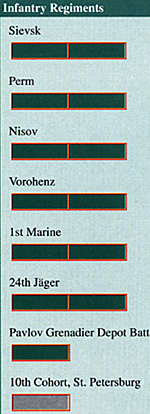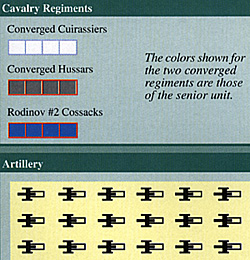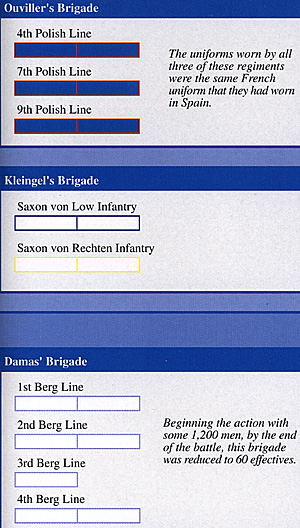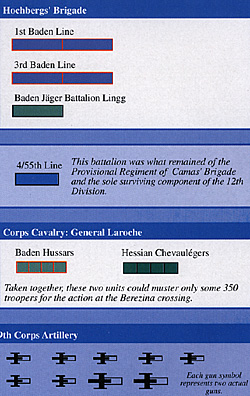Individual blocks represent either cavalry squadrons or infantry battalions. Cannon symbols represent two guns. The block colors represent the coat colors of each regiment, and the lines enclosing the blocks represent the regiment's facing or cuff colors. Order of Battle information from Napoleon's Invasion of Russia (1988), by George Nafziger, published by Presideo Press, Novato, California. Layout and data compilation by D.L. McElhannon.
Russian
The Russians had an infantry force of roughly 7,000 and a cavalry force of some 1,350 troopers present for the battle on the eastern side of the crossings. The blocks are uniform in size due to difficulty in breaking the numbers down into individual units. However, the number of battalions and squadrons present to each formation is correct.
Generallieutenant Berg's Corps
 |
 |
 |
 |
Ouviller's Brigade
-
4th Polish Line (2 bttns)
7th Polish Line (2 bttns)
9th Polish Line (2 bttns)
Kleingel's Brigade
-
Saxon von Low infantry (2 bttns)
Saxon von Rechten infantry (2 bttns)
Kleingel's Brigade
-
1st Berg Line (2 bttns)
2nd Berg Line (2 bttns)
3rd Berg Line (1 bttn)
4th Berg Line (2 bttns)
Beginning the action with 1,200 men, by the end of the battle, this brigade was reduced to 60 effectives.
Hochberg's Brigade
-
1st Baden Line (2 bttns)
3rd Baden Line (2 bttns)
Baden jager Bttn Lingg (1 bttn)
Camas' Brigade Remainder
- 4/55th Line (1 bttn)
This bttn was the sole surviving component of the 12th Division.
Corps Cavalry: General Laroche
Taken together, these two units mustered 350 troopers.
-
Baden Hussars (4 sqdns)
Hessian Chevaulegers (4 sqdns)
IX Corps Artillery
- The French had 18 guns, including four 12pdrs, available on the day of battle. The other 14 guns were probably 6pdrs, as the 3pdrs were among the items discarded at the beginning of the retreat.
Army Reserve Artillery
- Napoleon deployed a battery of 8 guns on the far bank of the Berezina in support of the hard pressed French right.
Stragglers
- There were between 5 and 15 thousand stragglers waiting to cross the bridges over the Berezina. Essentially worthless during the battle, many were left behind to fall into enemy hands after the action.
More 1812 Berezina Crossing
-
Back to Introduction
Overall Russia Campaign Map (slow--137K)
1812 Excerpt (part 1)
1812 Excerpt (part 2)
Rear Guard Action at the Berezina Crossing
Statistical Graph
Berezina Crossing Order of Battle (text--fast)
Berezina Crossing Order of Battle (graphics--very, very slow)
Berezina Diorama
Back to Table of Contents -- Napoleon #6
© Copyright 1996 by Emperor's Press.
This article appears in MagWeb (Magazine Web) on the Internet World Wide Web.
The full text and graphics from other military history magazines and gaming magazines are available at http://www.magweb.com